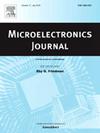用于二维和三维同步成像的基于尖峰的背景光抑制锁定像素
IF 1.9
3区 工程技术
Q3 ENGINEERING, ELECTRICAL & ELECTRONIC
引用次数: 0
摘要
本文介绍了一种具有基于尖峰锁定像素的 32 × 32 ToF 图像传感器。该像素具有像素内背景光抑制电路,可将红外光转换为尖峰数,无需滤光片即可实现背景光的自我抑制。这种像素结构可实现二维和三维同步成像。该 ToF 图像传感器采用 110 纳米单层四金属 CMOS 技术实现,尺寸为 3903 μm × 3330 μm。锁定像素是该传感器的关键部分,尺寸为 27.5 μm × 27.5 μm。测量结果表明,该 ToF 图像传感器在不使用滤光片的情况下,可在 0-12000 勒克斯的背景光范围内对 20 厘米-45 厘米的范围进行成像,最大相对误差为 3.6%。因此,这种带有拟议锁相像素的 ToF 图像传感器无需滤光片即可有效抑制背景光,实现二维和三维同步成像。本文章由计算机程序翻译,如有差异,请以英文原文为准。
A spike-based background light suppression lock-in pixel for 2D&3D synchronous imaging
In this paper, a 32 × 32 ToF image sensor with a spike-based lock-in pixel is presented. The pixel has an in-pixel background light suppression circuit which converts the infrared light into spike number and realizes self-suppression of the background light without filter. This pixel structure can realize 2D and 3D synchronous imaging. This ToF image sensor is implemented in a 110 nm one-poly four-metal CMOS technology with a size of 3903 μm × 3330 μm. The lock-in pixel as the key part of this sensor has a size of 27.5 μm × 27.5 μm. Measurement results show that this ToF image sensor can image in the range of 20 cm–45 cm under the background light range of 0–12000 lux without filter and the maximum relative error is 3.6 %. Therefore, this ToF image sensor with the proposed lock-in pixel can suppress background light effectively without filter and realize 2D and 3D synchronous imaging.
求助全文
通过发布文献求助,成功后即可免费获取论文全文。
去求助
来源期刊

Microelectronics Journal
工程技术-工程:电子与电气
CiteScore
4.00
自引率
27.30%
发文量
222
审稿时长
43 days
期刊介绍:
Published since 1969, the Microelectronics Journal is an international forum for the dissemination of research and applications of microelectronic systems, circuits, and emerging technologies. Papers published in the Microelectronics Journal have undergone peer review to ensure originality, relevance, and timeliness. The journal thus provides a worldwide, regular, and comprehensive update on microelectronic circuits and systems.
The Microelectronics Journal invites papers describing significant research and applications in all of the areas listed below. Comprehensive review/survey papers covering recent developments will also be considered. The Microelectronics Journal covers circuits and systems. This topic includes but is not limited to: Analog, digital, mixed, and RF circuits and related design methodologies; Logic, architectural, and system level synthesis; Testing, design for testability, built-in self-test; Area, power, and thermal analysis and design; Mixed-domain simulation and design; Embedded systems; Non-von Neumann computing and related technologies and circuits; Design and test of high complexity systems integration; SoC, NoC, SIP, and NIP design and test; 3-D integration design and analysis; Emerging device technologies and circuits, such as FinFETs, SETs, spintronics, SFQ, MTJ, etc.
Application aspects such as signal and image processing including circuits for cryptography, sensors, and actuators including sensor networks, reliability and quality issues, and economic models are also welcome.
 求助内容:
求助内容: 应助结果提醒方式:
应助结果提醒方式:


